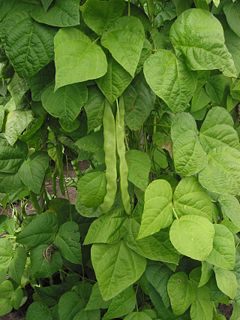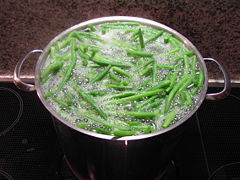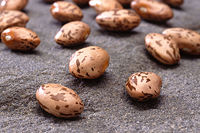Common bean
| Phaseolus vulgaris | ||||||||||||||||||
|---|---|---|---|---|---|---|---|---|---|---|---|---|---|---|---|---|---|---|
 Plant with immature fruit
|
||||||||||||||||||
| Scientific classification | ||||||||||||||||||
|
||||||||||||||||||
| Binomial name | ||||||||||||||||||
| Phaseolus vulgaris L. |
The common bean, Phaseolus vulgaris, is an herbaceous annual plant domesticated independently in ancient Mesoamerica and the Andes, and now grown worldwide for its edible bean, popular both dry and as a green bean. The leaf is occasionally used as a leaf vegetable, and the straw is used for fodder. Botanically, the common bean is classified as a dicotyledon. Beans, squash and maize constituted the "Three Sisters" that provided the foundation of Native American agriculture. As a legume, beans provided the nitrogen-fixing bacteria which supplied that essential nutrient to the other two crops.
Contents |
Description
The common bean is a highly variable species with a long history. Bush varieties form erect bushes 20–60 cm tall, while pole or running varieties form vines 2–3 m long. All varieties bear alternate, green or purple leaves, divided into three oval, smooth-edged leaflets, each 6–15 cm long and 3–11 cm wide. The white, pink, or purple flowers are about 1 cm long, and give way to pods 8–20 cm long, 1–1.5 cm wide, green, yellow, black or purple in color, each containing 4–6 beans. The beans are smooth, plump, kidney-shaped, up to 1.5 cm long, range widely in color, and are often mottled in two or more colors.
As the common bean is a dicot, it germinates as such:
- The primary root emerges through the seed coats while the seed is still buried in the soil.
- The hypocotyl emerges from the seed coats and pushes its way up through the soil. It is bent in a hairpin shape — the hypocotyl arch (Crozier's hook) — as it grows up. The two cotyledons protect the epicotyl structures — the plumule — from mechanical damage.
- Once the hypocotyl arch emerges from the soil, it straightens out. This response is triggered by light (phototropism). While this may be caused by most wavelengths of light, the critical photoperidic mechanism is sensitive to red or far red light. This mechanism is crucial, not only to Phaseolus beans, but to most flowering plants. It defines the phenology of their growth, and in some cases growth habits.
- The cotyledons spread apart, exposing the epicotyl, consisting of two primary leaves and the apical meristem.
- In many dicots, the cotyledons not only supply their food stores to the developing plant but also turn green and make more food by photosynthesis until they drop off.
Nutrition and preparation
| Kidney beans, raw Nutritional value per 100 g (3.5 oz) |
||||||||||||||||||||||||
|---|---|---|---|---|---|---|---|---|---|---|---|---|---|---|---|---|---|---|---|---|---|---|---|---|
| Energy 330 kcal 1390 kJ | ||||||||||||||||||||||||
|
||||||||||||||||||||||||
| Percentages are relative to US recommendations for adults. Source: USDA Nutrient database |
||||||||||||||||||||||||
| Green beans (snap beans) Nutritional value per 100 g (3.5 oz) |
||||||||||||||||
|---|---|---|---|---|---|---|---|---|---|---|---|---|---|---|---|---|
| Energy 30 kcal 130 kJ | ||||||||||||||||
|
||||||||||||||||
| Percentages are relative to US recommendations for adults. Source: USDA Nutrient database |
||||||||||||||||
Toxicity
Before they are eaten, the raw bean seeds should be soaked in water for several hours and then boiled for at least ten minutes in new fresh water to degrade a toxic compound - the lectin phytohaemagglutinin - found in the bean which would otherwise cause severe gastric upset. This compound is present in many varieties (and in some other species of bean), but is especially concentrated in red kidney beans and white kidney beans (Cannellini beans). Although in the case of dry beans the ten minutes required to degrade the toxin is much shorter than the hours required to fully cook the beans themselves, outbreaks of poisoning have been associated with the use of slow cookers whose low cooking temperatures may be unable to degrade the toxin. Sprouts of pulses high in haemaglutins should not be eaten. Kidney beans, especially, should not be sprouted.[1][2]
Dry beans
Similar to other beans, the common bean is high in starch, protein and dietary fiber and is an excellent source of iron, potassium, selenium, molybdenum, thiamine, vitamin B6, and folic acid.
Dry beans will keep indefinitely if stored in a cool, dry place, but as time passes, their nutritive value and flavor degrade and cooking times lengthen. Dried beans are almost always cooked by boiling, often after having been soaked for several hours. While the soaking is not strictly necessary, it shortens cooking time and results in more evenly textured beans. In addition, discarding one or more batches of soaking water leaches out hard-to-digest complex sugars that can cause flatulence, though those who eat beans regularly rarely have difficulties with flatulence as intestinal flora adjust. There are several methods including overnight soaking, and the power soak method, which is to boil beans for three minutes, then set them aside for 2-4 hours, then drain and discard the water and proceed with cooking. Common beans take longer to cook than most pulses: cooking times vary from one to four hours but are substantially reduced with pressure cooking.
In Mexico, Central America and South America, the traditional spice to use with beans is epazote, which is also said to aid digestion. In East Asia a type of seaweed, Kombu, is added to beans as they cook for the same purpose. Salt, sugar, and acidic foods like tomatoes may harden uncooked beans resulting in seasoned beans at the expense of slightly longer cooking times.
Dry beans may also be bought pre-cooked and canned as refried beans, or whole with water, salt, and sometimes sugar.
Green beans

Green common beans are also called string beans, stringless beans (depending on whether the pod has a tough, fibrous "string" running along its length), or snap beans. Compared to the dry beans, they provide less starch and protein, and more vitamin A and vitamin C. The green beans are often steamed, stir-fried, or baked in casseroles.
Shelling beans
As with other beans, prominent among them lima beans, soybeans, peas, and fava beans, common beans can be used for fresh shell beans, can also be called shelling beans, which are fully mature beans harvested from the pod before they have begun to dry.
Nutritionally, shell beans are similar to dry beans, but in the kitchen are treated as a vegetable, often steamed, fried, or made into soups.
Popping beans
The nuña is an Andean subspecies, Phaseolus vulgaris subsp. nunas (formerly Phaseolus vulgaris (Nuñas Group)), with round multicolored seeds which resemble pigeon eggs. When cooked on high heat, the bean explodes, exposing the inner part, in the manner of popcorn and other puffed grains.
Varieties

Many well-known bean varieties belong to this species, and none of the lists below are in any way exhaustive. Both bush and running (pole) varieties exist. The colors and shapes of pods and seeds vary tremendously.
Snap or String beans
Stephen Facciola's Cornucopia lists 130 varieties of snap beans. Varieties specialized for use as green beans, selected for the succulence and flavor of their pods, are the ones usually grown in the home vegetable garden, and many varieties exist. Pod color can be green, golden, purple, red, or streaked. Shapes range from thin "fillet" types to wide "romano" types and more common types in between. French Haricots verts (green beans) are bred for flavorful pods.
- Blue Lake (green)
- Dragon's Tongue (streaked)
- Golden Wax (golden)
- Purple King (purple)
- Red Swan (red)
Shell beans

Cornucopia lists 37 varieties of shell beans. The light green Flageolet bean is taken very seriously in France and soon the heirloom Chevrier will come under a controlled label reminiscent of the wine "Appellation d'Origine Controllée" called "Label Rouge". A number of other beans are already produced under this label.
Flageolet bean varieties include:
- Chevrier (the original heirloom)
- Elsa
- Flambeau
- Flamingo

Borlotti beans originated in North America where they are known by several names.[3] The bean is a medium large tan bean, splashed with red/black to magenta streaks. It is very popular in Italian and Portuguese cuisine.
The American cranberry bean or horticultural bean (also called cargamanto or romano) is quite similar if not the same as the Italian borlotti bean.[4] Pinto beans are not considered the same as borlotti beans.
- True Cranberry (old VT heirloom with a more round shape like a cranberry), traditional ingredient of succotash
Pinto or mottled beans


The pinto bean (Spanish: frijol pinto, literally "painted bean") is named for its mottled skin (compare pinto horse), hence it is a type of mottled bean. It is the most common bean in the United States [1] and northwestern Mexico [2], and is most often eaten whole in broth or mashed and refried. Either whole or mashed, it is a common filling for burritos. The young pods may also be used as green beans.
In the southwest United States, the pinto bean is an important symbol of regional identity, especially among Mexican Americans. Along with the chile/chilli, it is one of the official state vegetables of New Mexico (under the name frijol). The prepared beans are commonly known as frijoles. This type of bean is also referred to as "Cowboy Beans" in Texas, all along the Mexican border and wherever Mexican cowboys were employed. In areas where Mexican cowboys did not travel on the trails north from Texas, it was probably not known.
This is the most commonly used bean used for refried beans (fresh or canned) and in many dishes at Tex-Mex restaurants. Rice and pinto beans served with cornbread or corn tortillas are often a staple meal where there is limited money for meat, as the combination of beans and corn creates virtually all the protein amino acids needed in a meat substitute. [3] When it comes to making chili, if a bean is added, this is the one typically used, although the kidney bean, black bean, and many others may also be used in other locales (see below).
Pinto bean varieties include:
- Burke
- Othello
- Maverick
- Sierra
The alubia pinta alavesa, or the "Álava pinto bean", is a red variety of the pinto bean which originated in Añana,[5] a town and municipality located in the province of Álava, in the Basque Country of northern Spain. In October, "la Feria de la alubia pinta alavesa" (the fair of the Alubia pinta alavesa) is celebrated in Pobes.[6]
Anasazi
The Anasazi bean (aka Aztec bean, Cave bean, New Mexico Appaloosa) is a bean native to the North American Southwest.
White beans

The small, white navy bean, also called pea bean or haricot, is particularly popular in Britain and the US, featuring in such dishes as baked beans as well as in various soups such as the famous Senate Bean Soup.[7]
Navy bean varieties include:
- Great northern beans
- Rainy River
- Robust
- Michelite
- Sanilac
Other white beans are Cannellini (a quite popular variety in Central and Southern Italy) and Great Northern.
Red or kidney beans

The kidney bean with its dark red skin is named for its visual resemblance to a kidney. The kidney bean is also known as the red bean, although this usage can cause confusion with other red beans. Red kidney beans (rājmā in Hindi and Punjabi, Kārāmani or Kārāmani Payir Tamil) are an integral part of the cuisine in northern and also southern region of India. In Tamilnadu during the Tamil-Hindu festival Kaaradaiyaan Nonbu (Kamakshi Nonbu) a kind of sweet dish called Kozhukattai (steamed sweet cake) prepared with cooked and mashed kidney bean mixed with jaggery, ghee and other sub ingredients. Sometimes kidney beans are used in the red beans and rice of Louisiana Creole cuisine. Other times small red beans are used. Small red beans are noticeably smaller and darker than kidney beans. They have a smoother taste and are preferred for Cajun cuisine. Small kidney beans used in La Rioja, Spain, are called Caparrones.
Black beans

The small, shiny black turtle bean is especially popular in Latin American cuisine. It is often called simply the black bean (frijol negro in Spanish, feijão preto in Portuguese), although this can cause confusion with other black beans.
The black turtle bean has a dense, meaty texture and flavor reminiscent of mushrooms, which makes it popular in vegetarian dishes such as the Mexican-American black bean burrito. It is a very popular bean in various regions of Brazil, and is used in the national dish, feijoada. It is also a principal ingredient of Platillo Moros y Cristianos in Cuba, is a must-have in the typical gallo pinto of Nicaragua, and is served in almost all of Latin America as well as many Hispanic enclaves in the United States.
Black turtle beans have recently been reported to be an extremely good source of nutritional antioxidants.[8]
Black turtle bean varieties include:
- Black Magic
- Blackhawk
- Domino
- Nighthawk
- Valentine
Pink beans
Pink beans are small oval-shaped beans, pale pink in color, also known by the Spanish name Habichuelas Rosadas[4]. The most famous pink bean is the Santa Maria pinquito (spanglish = pink and small(ito) which is commercially grown on the mesas above Santa Maria, California, and is a necessary ingredient in Santa Maria Tri-tip barbecue.
Yellow beans
Sinaloa Azufrado, Sulphur, Mayocoba, and Peruano (also called Canary) are types of yellow beans.
Peruano beans (also called Canary beans) are small, oval, yellow coloured beans about 1/2 inch (1 cm) long with a thin skin. Peruano Beans have a creamy texture when cooked, and are one of the top-selling beans in Mexico City since 2005 (being native to Mexico, despite the name).
See also
- Azuki bean
- Bean - for other genera and species of beans
- Chickpea
- Dal
- Lentil
- List of common bean diseases
- Mung bean
- Pulse (legume)
- Broad bean
References
- ↑ "Kidney Beans". The world's healthiest foods. Retrieved on 2007-11-05.
- ↑ "Foodborne Pathogenic Microorganisms and Natural Toxins Handbook:Phytohaemagglutinin". United States Food and Drug Administration. Retrieved on 2007-11-06.
- ↑ UKTV Food: Tips and advice: Borlotti beans
- ↑ More on Borlotti on about.com. Retrieved 3 October 2005.
- ↑ Recetas para acordarse de sabores perdidos: "Añana. Es el origen de la alubia pinta alavesa y, como tal, esta legumbre pesa en su cocina. Ya sea en cocido, crema o sopa. El queso Idiazábal o el conejo son otros de sus manjares." (Spanish)
- ↑ Algunas de las ferias tradicionales en Euskadi: "La Feria de la alubia pinta alavesa, que se celebra en octubre en la localidad de Pobes." (Spanish)
- ↑ Senate Bean Soup
- ↑ Choung MG, Choi BR, An YN, Chu YH, Cho YS. Anthocyanin profile of Korean cultivated kidney bean (Phaseolus vulgaris L.) J Agric Food Chem. 2003 Nov 19;51(24):7040-3. Retrieved 6 August 2006.
External links
- Fact sheet with nutritional information on pinto beans at WHFoods.org
- Introducing flageolet beans on the Multilingual Multiscript Plantname Database site.
- Lost Crops of the Incas, p 174 displays a popped seed of P. vulgaris nunas. (An extremely attractive color photograph by J. Kucharski featuring many cultivars can be found in Lost Crops of the Incas between p 192 & p 193, unfortunately not shown on web site).
- Plant lectins
- USAID fact sheet with nutritional information on black beans.
- USAID fact sheet with nutritional information on pinto beans.